Showing top 0 results 0 results found
Showing top 0 results 0 results found

Are you exploring ways to enhance your customer service experience and operational efficiency but are tangled up in today's tech buzzwords? The term "RPA chatbot" might just be the key to unlocking a new level of automation and customer satisfaction for your business.
It's no secret that chatbot interactions boast a higher satisfaction rate—around 87.58%—than those of live chats with humans. This statistic alone underscores the transformative impact these technologies can have on businesses.
However, it is crucial to leverage their full potential to understand the nuances, applications, and tools available for robotic process automation (RPA) and chatbots.
In this article, we'll demystify these technologies and explore their unique roles in the digital landscape. Here's a sneak peek of what we'll cover:
- What is RPA?
- The mechanics of RPAs in action.
- Distinguishing RPAs from chatbots.
- How RPA chatbots boost business and customer service.
- How to pick the right RPA chatbot provider.
- Getting started with an RPA chatbot provider.
- Comparing top RPA chatbot software tools.
- Understanding chatbot APIs.
What is RPA?
RPA is essentially a virtual workforce designed to automate repetitive and rule-based tasks that humans used to do. This includes everything from data entry and invoice processing to email sorting, all performed with impressive speed and accuracy.
RPA bots act as your organization's behind-the-scenes ninja, quietly and efficiently taking care of mundane tasks and automating business processes that consume your team's time. Imagine having a team that never sleeps, doesn’t make mistakes, and can work at lightning speed. That’s RPA for you.
By automating these routine tasks, RPA frees up your human workforce to focus on more strategic, creative activities that genuinely add value, thereby increasing employee satisfaction and engagement.
It’s like giving your business an efficiency boost, allowing you to utilize your resources better and focus on innovation and growth.
🤖 Never heard of ChatBot before?
How do RPAs work?

Software robots streamline repetitive digital tasks through intelligent automation, accessing and processing relevant information across your IT systems. Here’s a quick breakdown of the types of RPA:
- Attended RPA: This type works alongside humans, helping with tasks that require a bit of human touch.
- Unattended RPA: Completely independent, these robots work solo, perfect for high-volume, repetitive tasks that don't need supervision.
- Hybrid RPA: A blend of both attended and unattended, offering flexibility and efficiency.
Each RPA technology type has its specific role, from enhancing human tasks with intelligent automation to managing data-heavy processes independently or combining both approaches for a balanced automation solution.
This tailored approach ensures that every task, whether it benefits from human intervention or can be fully automated, is handled in the most efficient way possible, making your operations smoother and more productive through artificial intelligence and machine learning.
What are the differences between RPA and chatbots?
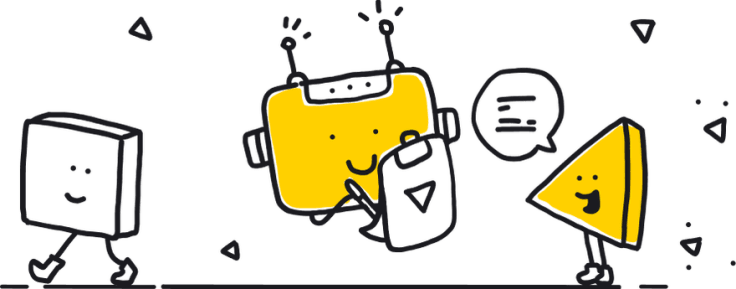
At first glance, RPA and chatbots might seem like two peas in a pod, both designed to automate and simplify. Yet, they play distinct roles in the symphony of your business operations. Let’s break down their differences in a way that’s easy to digest.
Talking vs. doing
- Chatbots: Your digital chatterboxes, employing conversational AI and natural language processing (NLP) technology to engage users and answer questions in a manner that feels surprisingly human.
- RPA: The silent doers, loving the routine of structured, rule-based tasks without ever breaking a sweat.
Customer frontline vs. operational backbone
- Chatbots: They're the face of your digital customer service, ready to troubleshoot or guide users with the patience of a saint, 24/7.
- RPA: Think of them as the diligent workers in the back office, handling the repetitive tasks that keep the business humming smoothly.
Engaging conversations vs. silent productivity
- Chatbots: Designed for dialogue, they’re the ones keeping your customers engaged, making interactions as natural as chatting with a friend.
- RPA: Your business's unsung heroes, working tirelessly behind the scenes, ensuring every process ticks along without needing a moment to catch its breath.
By understanding these key differences, you can better leverage each tool's strengths, whether it's enhancing customer interaction with chatbots or streamlining back-office operations with RPA.
It’s not about choosing one over the other but recognizing how both RPA and chatbot technology can coexist and complement each other to drive your business forward with advanced automation solutions.
How RPA chatbots can help your business
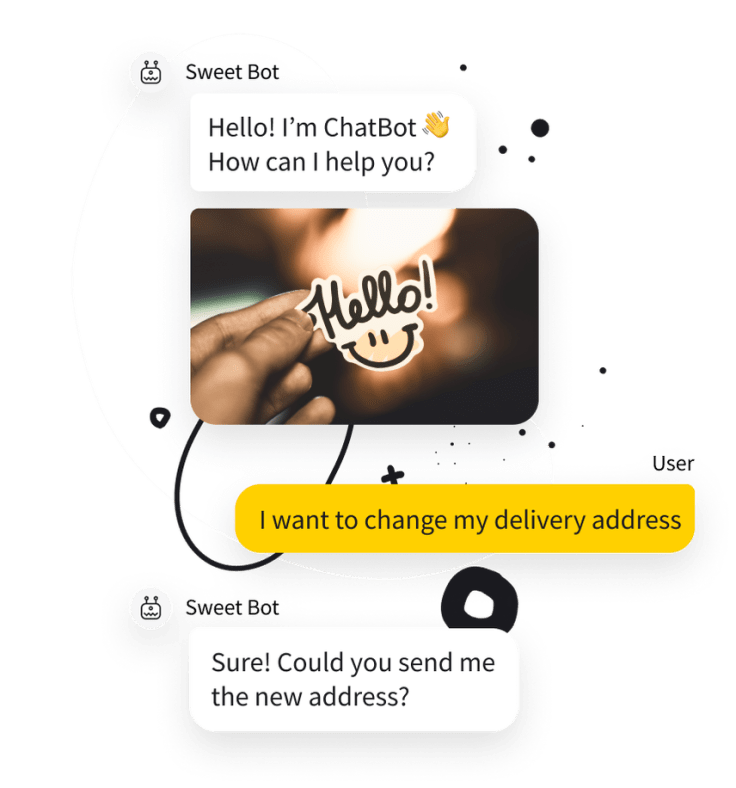
RPA chatbots are revolutionizing how businesses interact with their customers and manage internal processes. Here's how they can benefit your business:
- Streamline customer interactions: Chatbots can handle inquiries about account openings and complaints, providing quick responses 24/7.
- Automate repetitive tasks: They excel in repetitive tasks like data entry, report generation, and order processing, freeing up human workers for more complex tasks.
- Seamless data exchange: Chatbots can effortlessly exchange and integrate data across systems, ensuring accurate and up-to-date information.
- Enhance decision-making: With their ability to gather and analyze data, chatbots support better business decisions.
- Improve customer service processes: Handling returns, refunds, and product recommendations becomes more efficient, enhancing customer satisfaction.
- Streamline HR and administrative tasks: From hiring and onboarding to managing contracts and conducting satisfaction surveys, chatbots can significantly reduce the workload.
Benefits of RPA solutions
RPA offers a myriad of benefits that can significantly impact the efficiency and productivity of a business. Here's how:
Accelerated processes and reliability
RPA bots execute tasks with remarkable speed and precision, reducing the likelihood of errors associated with human intervention. This consistent reliability ensures processes are completed efficiently, enhancing overall productivity.
Cost savings
By automating routine tasks, RPA systems reduce the need for redoing work due to errors, saving on operational costs. This efficiency translates into considerable financial savings for businesses.
Boosted employee productivity
Freeing employees from monotonous tasks allows them to focus on more complex and rewarding work, leading to higher job satisfaction and performance levels.
Enhanced customer satisfaction
The implementation of RPA in customer-facing services ensures high-quality interactions, resulting in increased customer loyalty and satisfaction.
Versatility across industries
RPA's adaptability allows it to serve a variety of functions across different sectors, automating tasks from information validation in finance to inventory updates in retail.
Improved IT management
With its ability to monitor networks and improve operational quality, RPA plays a crucial role in IT management, facilitating quicker response times to issues.
🤖 Never heard of ChatBot before?
What to look for in an RPA chatbot provider

Picking the right RPA chatbot provider is key. Here's what to keep an eye out for:
- Ease of setup: Look for an RPA that smoothly slides into your current systems without needing a total overhaul.
- User-friendly: Choose one that's easy enough for anyone on your team to use, reducing training time and headaches.
- Speed: Opt for an RPA that quickly handles those repetitive tasks, giving your team more time for important work.
- Integration abilities: It should easily integrate with your existing software, making sure everything communicates well and runs smoothly.
- Technical requirements: Ensure RPA matches your current tech environment and won't become obsolete as you upgrade your systems.
- Scalability: Your chosen RPA should be able to scale with your business, managing more tasks as your needs grow.
- Cost: Look for an RPA that provides value, considering both the initial investment and long-term operational costs.
How to get started with an RPA chatbot provider
Mixing chatbots with RPA is like putting a smart digital assistant together with a behind-the-scenes doer. Picture a chatbot from ChatBot as your front desk, greeting everyone and figuring out what they need, from simple answers to guiding them through more complex services.
When it's time to deal with the old-school systems that run in the background, RPA takes the stage, doing the heavy lifting without anyone needing to intervene.
To get this dynamic duo up and running, here's a simple step-by-step guide:
- Start with the chatbot: Set up your chatbot on ChatBot. Make it your first point of contact for users, teaching it to understand and respond to customer needs with its smart language skills.
- Identify the tasks: Pinpoint which tasks need a handoff to RPA. These are usually tasks that involve digging into older systems that the chatbot can't access directly.
- Set up RPA: Introduce RPA into the mix to take over tasks from the chatbot. This involves configuring RPA to access and work with your legacy systems, doing things like retrieving data or updating records.
- Seamless handoff: Create a smooth process for the chatbot to hand off tasks to RPA when it encounters a request that involves legacy systems.
- RPA takes action: RPA works quietly in the background, carrying out the necessary actions without any fuss.
- Close the loop: Once RPA finishes its job, make sure the chatbot can pick up where it left off, delivering any results or confirmations to the user.
Following these steps bridges the gap between modern chat interfaces and traditional backend systems. It's all about making technology work smarter, enhancing efficiency, and improving the overall experience for everyone involved.
9 best RPA chatbot software tools
Navigating the world of RPA chatbot software can be a bit of a maze, but the right tools can make it a breeze to enhance customer service, automate tasks, and improve overall efficiency. Here’s a quick look at some standout options in the market:
1. ChatBot

ChatBot stands out with its AI-driven chatbot solution that doesn’t require coding skills for setup. It’s designed to deliver quick and accurate AI-generated answers by leveraging your own resources.
A key advantage is its standalone AI, which operates independently of third-party providers, ensuring data security and customizable communication.
Prices start at $52/month for small companies, scaling up to custom pricing for large-scale businesses, making it versatile for various business sizes.
2. AlphaChat
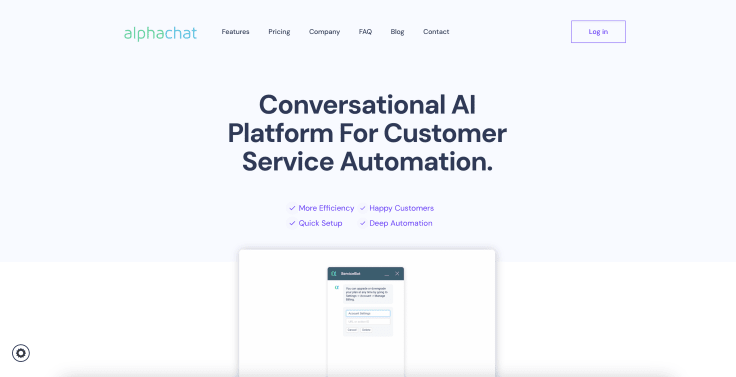
AlphaChat impresses with its built-in Natural Language Understanding and ability to authenticate users through deep RPAs. It’s perfect for creating conversational AI bots with a no-code interface, offering a powerful tool for both customer service and sales.
There is a 10-day free trial and plans start from €399/month, making it a strong contender for businesses looking to launch RPA chatbots quickly.
3. Meya
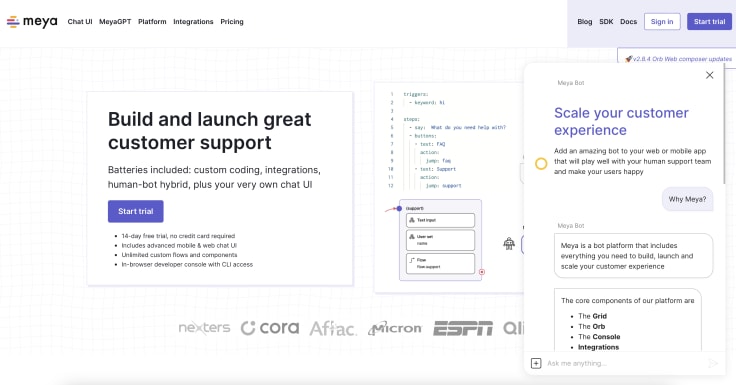
Meya specializes in creating customizable virtual assistants and robotic automation with features like multiple cloud hosting and third-party integrations. It offers its own Bot Flow Markup Language, catering to developers who wish to dive deep into chatbot building.
Plans start at $799/month, positioning Meya as a choice for companies with specific customization needs.
4. Aivo
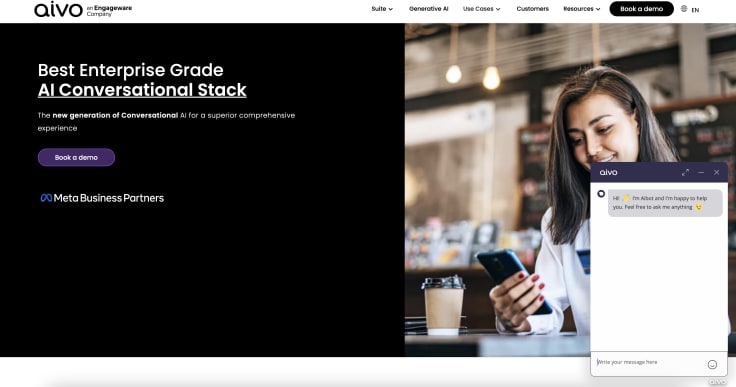
Aivo focuses on omnichannel customer service automation, integrating with major platforms and offering features like live chat and virtual assistant training.
Its pricing starts at $99/month plus $0.15 per conversation, making it accessible for businesses prioritizing seamless customer service across various channels.
5. Ebi
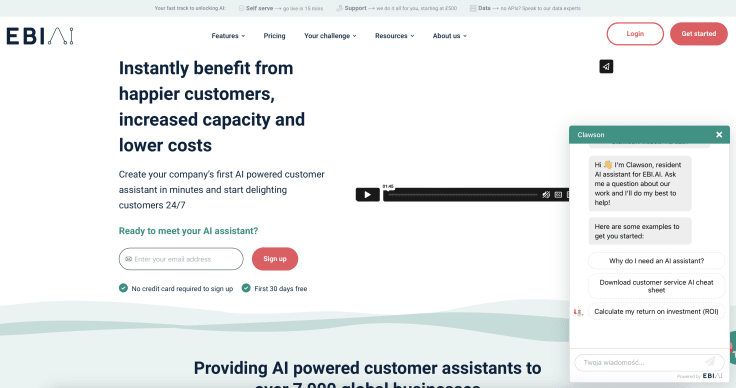
Ebi uses IBM Watson machine learning models for building chatbots, offering connections to voice bots and multi-channel deployment.
It’s geared towards businesses looking for custom virtual assistant development projects, with prices available upon request.
6. Solvvy
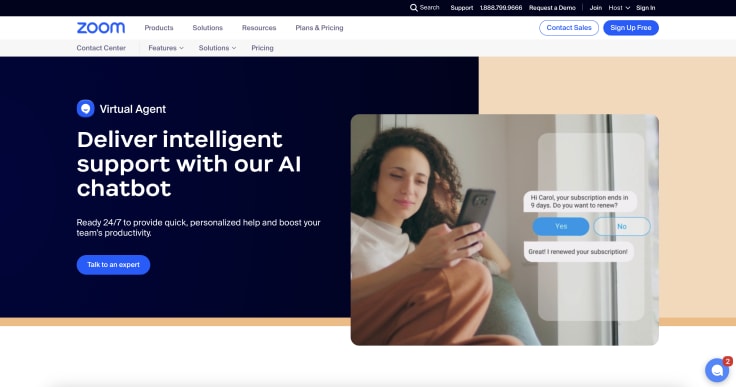
Solvvy excels in building no-code workflows for customer support automation, particularly for subscription-based businesses. Its tools for automating customer support through workflow builders are a highlight.
Pricing is available on request.
7. Hyro
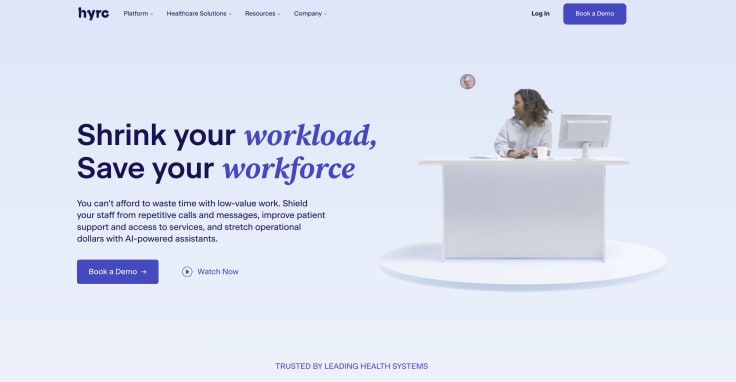
Hyro stands out in the healthcare, government, and real estate sectors by parsing existing data to create conversational interfaces. Its focus on these specific industries allows for tailored solutions.
Pricing is available on request.
8. Activechat.ai
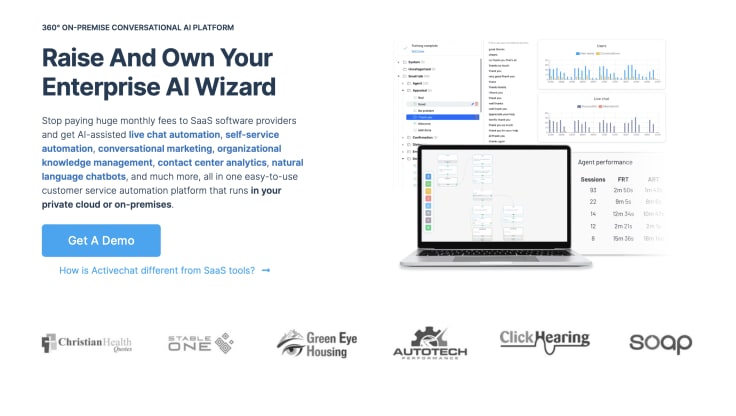
Activechat.ai combines smart AI chatbots with a live chat tool and conversational intelligence module, offering comprehensive customer interaction automation.
Starting at $33/agent/month, it’s a cost-effective option for businesses aiming to enhance their customer service through automation.
How does a chatbot API work?
Understanding how a chatbot API works can demystify the magic behind these conversational bots that are becoming increasingly prevalent in customer service, ecommerce, and more. At its core, a chatbot API processes messages through a few key steps:
- Intent recognition: This is where the chatbot figures out what the user is asking or looking for. The chatbot identifies keywords or phrases that indicate the user's intent by analyzing the user's message.
- Generating response: Once the intent is understood, the chatbot begins crafting an appropriate response. This could be pulling information from a database, calculating an answer, or selecting a predefined response that matches the intent.
- Deliver response: The final step is delivering the response to the user. This involves the chatbot API sending the generated response through the platform (like a website, app, or messaging service) to the user, completing the cycle of communication.
Each of these steps involves complex algorithms and programming, but the end goal is simple: to provide a seamless and helpful interaction for the user.
Who uses chatbot APIs?
Chatbot APIs have found their way into various sectors, becoming an indispensable tool for many. Here’s who is leveraging these smart conversational interfaces:
- Developers and engineers: They use chatbot APIs to build and integrate sophisticated chatbots into websites, applications, and systems, enhancing user interaction and automating responses.
- Enterprises: Big businesses adopt chatbot APIs to streamline customer service, automate workflows, and provide instant support, thereby improving operational efficiency and customer satisfaction.
- Messaging platforms and social media: These platforms integrate chatbot APIs to offer users enhanced engagement options, enabling businesses to reach out to customers directly through popular channels.
- Healthcare industry: Healthcare providers utilize chatbot APIs for patient engagement, appointment scheduling, and providing health information, making healthcare access easier and more efficient.
- Ecommerce platforms: Ecommerce businesses employ chatbot APIs to assist customers in product selection, order processing, and customer service, creating a personalized shopping experience.
Conclusion
Navigating today's tech landscape can be quite the journey, but combining RPA with chatbots is like discovering a shortcut to better efficiency and happier customers.
We've seen how this duo can transform everything from the way we handle customer queries to managing stock levels and even making hiring a breeze.
At ChatBot, we're all about making these cutting-edge tools accessible and easy to use. With our platform, integrating chatbots with RPA isn't just for the tech-savvy; it's for everyone looking to boost their business without getting bogged down in complexity.
Let's simplify the future together, making every interaction smoother and every process more streamlined. It's time to let the magic of automation work for you.
🤖 Never heard of ChatBot before?



